There are several types of eczema that look different across skin tones. People with lighter skin tones may develop skin redness, and on people with darker skin, these areas may appear purple or gray.
Some types of eczema also cause specific symptoms that distinguish them from others. For example, discoid eczema causes coin-shaped rashes.
This article looks at the different types of eczema affecting certain body parts. We also examine eczema in adults and children and provide slideshows of the types of eczema on different skin tones and bodies.
There are different types of eczema, including:
- Contact dermatitis: This skin condition occurs when a person receives contact with certain substances that trigger an allergic reaction. The rash usually appears in a pattern that follows the shape of the allergen, such as a wedding band. The main symptom is an itchy, scaly, dry, or inflamed rash.
- Atopic dermatitis (AD): This condition’s general symptoms tend to include itching and dry, scaly patches, but unlike contact dermatitis, the rash is not specific to one pattern or shape. Foods, environmental allergens, and genetics may trigger this type of eczema.
- Dyshidrotic eczema: This type causes water-filled blisters to appear on the skin. It may cause accompanying symptoms, including extreme itching and a burning sensation. Factors that can aggravate this condition include stress, sweating, and extreme temperatures.
- Discoid eczema: This condition results in coin-shaped plaques with raised spots and scaling. It tends to be more common in older adults and those with extremely dry skin, such as during winter.
- Varicose eczema: This skin condition causes swelling and itchy discolored skin. It usually occurs on the lower legs when circulation issues lead to varicose veins.
- Asteatotic eczema: Doctors
characterizeTrusted Source this type of eczema as dry, cracked skin, scaling, and itching that results from dry and colder climates.
On lighter skin tones, eczema tends to cause skin redness. Conversely, the condition can look brown, purple, or gray areas on darker skin.
The following slides show pictures of the types of eczema. To see all the images on one screen, click “view all.”
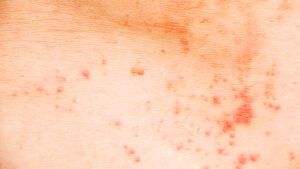
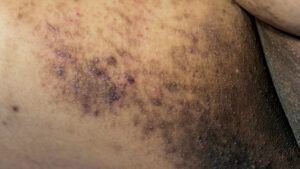
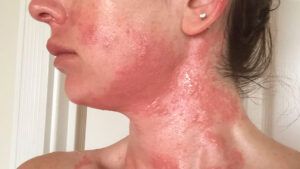
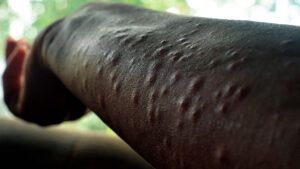
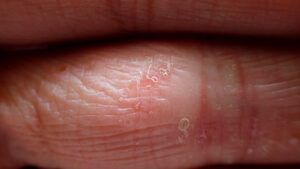

Warning
Contains Sensitive Content
Warning
Contains Sensitive Content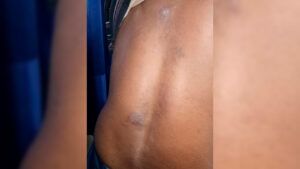

Warning
Contains Sensitive Content
These different types of eczema may occur on specific body parts more than others, including the:
The images in the slideshow below show some of the different areas of the body that eczema may affect.
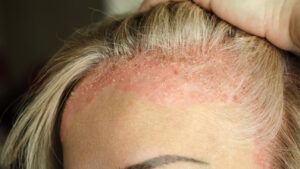
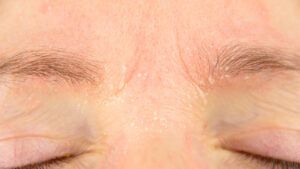
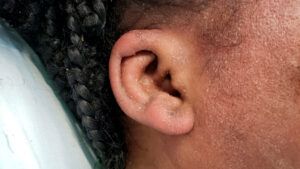

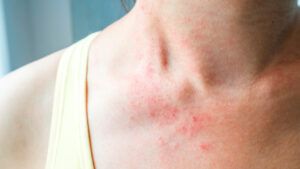
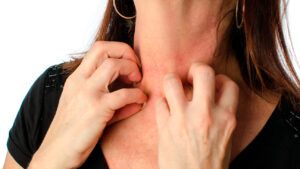
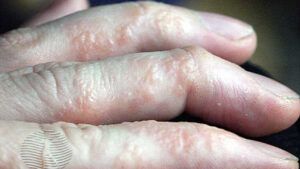
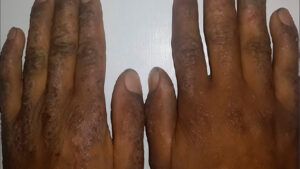
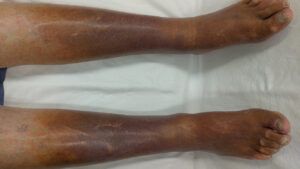
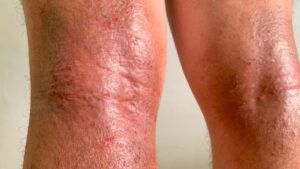

Warning
Contains Sensitive Content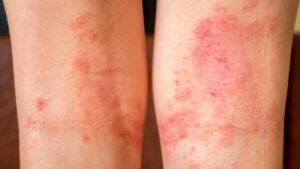

Warning
Contains Sensitive Content
Warning
Contains Sensitive ContentAdults can develop any type of eczema. If a person has had the condition for years, the skin may appear thick, rougher, and darker than the surrounding skin.
Specific types of eczema are more common in older adults. For example, varicose eczema tends to affect people over 50 years of age.
Additionally, asteatotic eczema affects those
Adults also usually develop eczema on different parts of their bodies compared with children. Adult eczema may form in one or more of the following areas:
- the backs of the knees
- the creases of the elbows
- the back of the neck
- the face
To see all the pictures, click “view all.”

Warning
Contains Sensitive Content
Warning
Contains Sensitive Content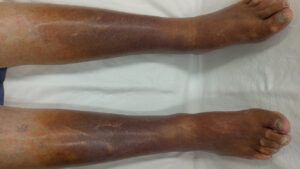
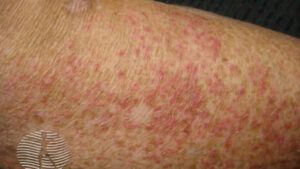
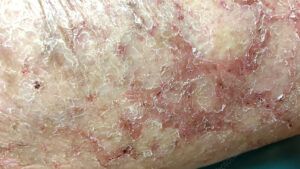
Eczema can appear on any area of the skin at any age. However, at certain ages, it is more likely to develop in some regions of the body.
Babies
In babies, eczema may occur on the scalp and face, particularly the cheeks. However, they rarely develop AD in the diaper area, as the skin stays too moist for AD. A rash in the diaper area usually indicates diaper rash.
Eczema often appears as a dry, raw, scaly rash. Itching may come and go, and any lesions may weep fluid in some cases.
Children
When eczema develops after the age of 2 years, it usually occurs as itchy and scaly patches in areas such as:
- the creases of the elbows and knees
- neck
- wrists
- ankles
- the crease between the buttocks and legs
Over time, the skin may change in appearance, causing it to become bumpy, discolored, and thicker, resulting in the skin becoming persistently itchy.
In the following slides, find examples of the areas that eczema affects in children.
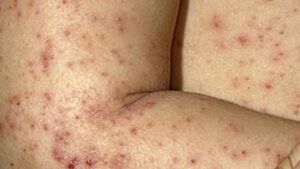
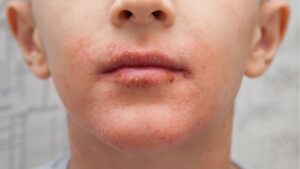
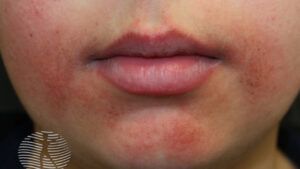
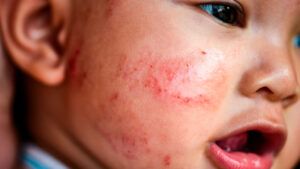
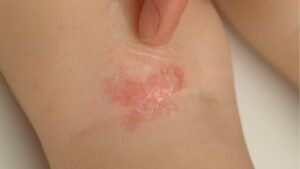
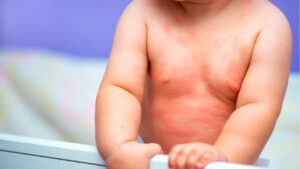
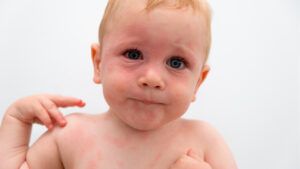
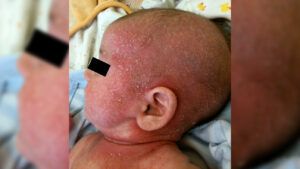
The causes of eczema vary depending on the type. For example, contact dermatitis often occurs due to a specific allergy or irritant, but AD is more complex, and does not have a single cause.
Examples of things that may cause or trigger eczema include:
- dry skin
- a family history of this condition
- allergies
- stress
- cold or damp environments
- warm and humid environments
- immune system dysfunction
- exposure to irritants, such as harsh chemicals
- COVID-19
There are several treatments available for eczema. These may include over-the-counter (OTC) or prescription medications or lifestyle changes, depending on the type of eczema.
- OTC treatments include topical and oral medications, such as antihistamines and hydrocortisone, to relieve itchiness
- prescription topical medications include:
- topical Janus kinase (JAK) inhibitors
- topical calcineurin inhibitors such as tacrolimus
- topical PDE4 inhibitors
- topical steroids
- prescription injectable medications, such as biologics
- prescription oral medications:
- immunosuppressants
- JAK inhibitors
- systemic medication
- steroids
- prescription phototherapy
There are several types of eczema, all of which generally cause patches of itchy, dry skin. However, different types of eczema have different causes, symptoms, and treatments.
For example, avoiding an allergen may relieve contact dermatitis, while ongoing management may be necessary for AD. Eczema can also look different in people of different ages and skin tones.
If a person has symptoms of a skin condition but is not sure what the cause is, they should speak with a doctor, as eczema can resemble other conditions that require medical treatment.

